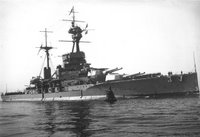Sunday Battleship Blogging: HMS Warspite

HMS Warspite was the second of the magnificent Queen Elizabeth class battleships. She carried 8 15″ guns, displaced 28000 tons, and could make nearly 25 knots. Warspite and her sisters outclassed every battleship in the world upon their commissioning, and remained useful and impressive ships until the end of World War II. Warspite led the most distinguished career of any Royal Navy battleship in the twentieth century.
Warspite and her four sisters constituted the Fifth Battle Squadron of the Grand Fleet, a designation designed to take advantage of the ship’s high speed. In ordinary operations, Warspite would have been part of the main battle line of the Grand Fleet, which would have limited her to a speed of somewhat less than 20 knots. The necessities of maneuvering in formation limited the speed of a squadron to somewhat less than that of its slowest ship. Warspite, thus, had difficulty operating with the rest of the Grand Fleet. While the US Navy solved this problem by designing all of its battleships with a common (slow) speed, the Royal Navy accepted a speed differential and pursued an organizational solution. In early 1916, the Fifth Battle Squadron was detached from the Grand Fleet and placed under Admiral David Beatty, commander of the Royal Navy battlecruisers.
Due largely to Beatty’s ineptitude, the Fifth Battle Squadron arrived late at the Battle of Jutland. Beatty’s battlecruisers were being taken to the woodshed by the High Seas Fleet when Warspite and her sisters arrived, diverting fire from Beatty’s wounded ships and inflicting serious damage on the already battered German ships. For a short period, the Fifth Squadron faced the whole of the High Seas Fleet. After turning away from the German fleet, Warspite suffered a mechanical “incident”. Her steering jammed, and she sailed in two full circles in front of the High Seas Fleet, receiving fifteen hits from German heavy guns. Warspite’s accident saved the armored cruiser Warrior, on the verge of sinking after taking heavy German fire. Warpite survived, and slowly made her way back to port, avoiding two German U-boat attacks along the way. The experience at Jutland helped Warspite acquire a reputation for poor luck; she also managed to ram her sisters Barham and Valiant, to run aground once, to suffer a boiler room fire, and was a close witness to the explosion of HMS Vanguard.
Warspite was modernized twice during the inter-war period. The second modernization was quite extensive, replacing the entire original superstructure and repairing some  of the damage leftover from Jutland. Warspite and her sisters remained useful in the Second World War largely due to their speed, and served with distinction in the North Sea and the Mediterranean. At the Second Battle of Narvik, Warspite helped to sink eight German destroyers trapped in a Norwegian fjord. Warspite was involved in several major actions in the Mediterranean, including the Battle of Calabria, where Warspite hit Giulio Cesare at a range of 26000 yards, thought to be the longest hit of one moving battleship against another. In 1941 Warspite was transferred to the Pacific and repaired at the Puget Sound Naval Yard before being attached to the Royal Navy’s Eastern Fleet in early 1942. The Eastern Fleet fought a few inconclusive actions with the Imperial Japanese Navy before being chased to the east coast of Africa. In 1943, Warspite was transferred back to the Mediterranean.
of the damage leftover from Jutland. Warspite and her sisters remained useful in the Second World War largely due to their speed, and served with distinction in the North Sea and the Mediterranean. At the Second Battle of Narvik, Warspite helped to sink eight German destroyers trapped in a Norwegian fjord. Warspite was involved in several major actions in the Mediterranean, including the Battle of Calabria, where Warspite hit Giulio Cesare at a range of 26000 yards, thought to be the longest hit of one moving battleship against another. In 1941 Warspite was transferred to the Pacific and repaired at the Puget Sound Naval Yard before being attached to the Royal Navy’s Eastern Fleet in early 1942. The Eastern Fleet fought a few inconclusive actions with the Imperial Japanese Navy before being chased to the east coast of Africa. In 1943, Warspite was transferred back to the Mediterranean.
Warspite’s service in 1943 focused mainly on support of British and American landings in Sicily and Italy. On September 15, 1943 a German glider bomb hit Warspite, tearing through her superstructure, her main deck, and her hull. Warpite had to be towed to port, and was never fully repaired. She participated in shore bombardment at the Normandy landings, but hit a mine shortly afterward. Pieced together enough to deliver further shore bombardment in late 1944, she was retired in early 1945.
A campaign to preserve Warspite after World War II failed. Although the reluctance  of the cash-strapped post-war British government to spend money on preserving a battered, aging battleship is understandable, it is nonetheless unfortunate that no British capital ships of the twentieth century survive. Warspite, the most active of Royal Navy battleships and the most beloved of the British public, would undoubtedly have been the best choice for preservation. On the way to being scrapped in 1947, Warpite ran aground. She was taken apart over the course of the next three years.
of the cash-strapped post-war British government to spend money on preserving a battered, aging battleship is understandable, it is nonetheless unfortunate that no British capital ships of the twentieth century survive. Warspite, the most active of Royal Navy battleships and the most beloved of the British public, would undoubtedly have been the best choice for preservation. On the way to being scrapped in 1947, Warpite ran aground. She was taken apart over the course of the next three years.
(Images courtesy of www.maritimequest.com)
Trivia: What battleship was the sole survivor of the June 21, 1919 “incident” at Scapa Flow?


